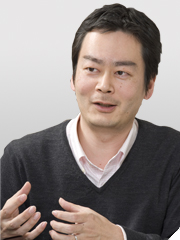Inside Story


- Planning and Design
- Special functions
- Enhanced functions
Response exceeds expectations

"The response prior to launch was
amazing."(Shigeki Takeuchi)
"I was amazed at the strong attention this camera attracted even before it went on sale," said Shigeki Takeuchi, CX1 marketing leader. "It is my job to 'communicate' the appeal of the CX1 compact digital camera to as many people as possible, but even I was shocked at the degree to which the CX1 became a hot topic even before its official launch." Introduced on March 13, 2009, the CX1 has attracted widespread attention for the way that it has succeeded in expanding the "range of expression" for compact digital cameras.
What does it actually mean to say that the CX1 expands the "range of expression"? Let's take a look at some of the CX1's main features.
- 1.Expanded "dynamic range*" enables smooth reproduction of gradations from light to dark.
- 2.The new image processing engine "Smooth Imaging Engine IV" has been adopted.
- 3.With the extensive continuous shooting functions, you are sure to catch the desired scene.
- 4.The large, high-definition LCD makes every function easier to use.

Rich tonal gradations
even in clouds that tend
to end up uniformly
white. (Click to enlarge.)
- *Dynamic range: The range of brightness that the camera can process. When photographing in high-contrast situations, bright areas are subject to whiteout and detail can be lost in dark areas, the result being an image with a different feel than the actual scene. This occurs because the brightness range that cameras can process is narrower than that of the human eye. With a wide dynamic range, the camera smoothly reproduces gradations from bright areas to dark areas, creating an image that gives a nearly human-eye impression.
CMOS sensor adopted as image sensor

"We worked hard to find ways to
expand the range of expression."
(Hiroyuki Higuchi)
"At Ricoh, we have always worked to expand the shooting range of our digital cameras from both time and space perspectives, and with the CX1 we followed a design concept of further widen these boundaries to create an 'expanded range of expression' that brings the photographer closer to the image as envisioned," said planning chief Hiroyuki Higuchi.
With the CX1, Ricoh is expanding the photographer's range of expression from a variety of perspectives, but one factor deserving special mention is the use of CMOS sensors rather than CCD sensors as the camera's image sensor. "After extensive discussion with the development area concerning what needed to be done to realize our product concept, we adopted CMOS* as the sensor capable of doing what we needed to do. Often utilized in SLR cameras, CMOS image sensors boast features such as high-speed read processing and low power consumption," Higuchi said. The use of CMOS was essential for achieving the dynamic range expansion and enhanced continuous shooting functions that Higuchi sought.
- *CCD and CMOS sensors are both image sensors that convert incoming light to an electric charge, but they use different signal read techniques and exhibit different characteristics.
- Planning and Design |
- Special functions |
- Enhanced functions


